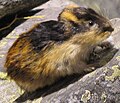Flora
310 species of vascular plants were said to be found in Greenland in 2019,[ citation needed ] including 15 endemic species[ citation needed ]. Although individual plants can be profuse in favourable situations, relatively few plant species tend to be represented in a given place.
In northern Greenland, the ground is covered with a carpet of mosses and low-lying shrubs such as dwarf willows and crowberries. Flowering plants in the north include yellow poppy, Pedicularis , and Pyrola . [2] [3] Plant life in southern Greenland is more abundant, and certain plants, such as the dwarf birch and willow, may grow several feet high.
The only natural forest in Greenland is found in the Qinngua Valley. The forest consists mainly of downy birch ( Betula pubescens ) and grey-leaf willow ( Salix glauca ), growing up to 7–8 metres (23–26 ft) tall, [4] although nine stands of conifers had been cultivated elsewhere by 2007. [1]
Horticulture shows a certain degree of success. Plants such as broccoli, radishes, spinach, leeks, lettuce, turnips, chervil, potatoes and parsley are grown up to considerable latitudes, while the very south of the country also rears asters, Nemophila , mignonette, rhubarb, sorrel and carrots. [3] Over the decade to 2007, the growing season lengthened by as much as three weeks. [1]
In the 13th-century Konungs skuggsjá (King's mirror), it is stated that the old Norsemen tried in vain to raise barley. [3] Recent research from archaeological digs on Greenland by the National Museum in Copenhagen discovered barley grains and concluded that the Vikings were able to grow barley. [5]
- Bog Bilberry (Arctic Blueberry)
Vaccinium uliginosum
Kigutaarnat nagguii / mosebølle / blåbær
Kigutaarnat, Blåbær - Dandelion
Taraxacum lacerum
inneruulaq / asorut / seqiniusaq / mælkebøtte
Inneruulaq; Asorut; Seqiniusaq, Mælkebøtte - Boreal cup lichen
Cladonia borealis Stenroos
orsuaasat ermusingasut /rensdyrlav
Orsuaasat ermusingasut, Bægerlav-familien

















































